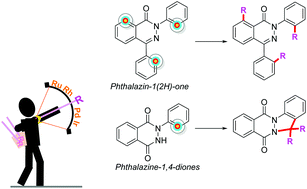Transition-metal-catalyzed C–H bond activation/functionalization and annulation of phthalazinones
Abstract
Phthalazinones and their higher congeners are commonly prevalent structural motifs that occur in natural products, bioactive molecules, and pharmaceuticals. In the past few decades, transition-metal-catalyzed reactions have received an overwhelming response from organic chemists as challenging organics and heterocycles could be built with ease. Currently, the synthesis of phthalazinones largely depends on transition-metal catalysis, especially by palladium-catalyzed carbonylation. Further, the dominance of transition-metal catalysts was realized from the phthalazinones viewpoint, as nitrogen and oxygen atoms endowed upon them act as directing groups to facilitate diverse C–H activation/functionalization/annulation reactions. This highlight describes the various synthetic methods used to access phthalazinones and functionalize them by reacting with various coupling partners via chelation assistance strategy involving C(sp2)–H/N–H bond activation in the presence of transition-metal (Rh, Ru, Pd, and Ir) catalysts. The mechanisms of sulfonylation, halogenation, acylmethylation, alkylation, and annulation reactions are discussed.

- This article is part of the themed collection: Catalysis & biocatalysis in OBC


 Please wait while we load your content...
Please wait while we load your content...